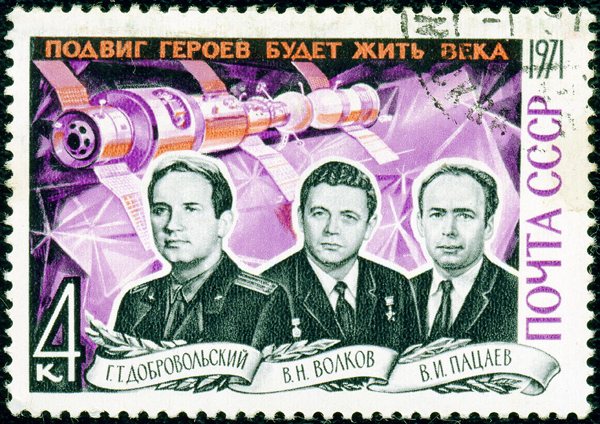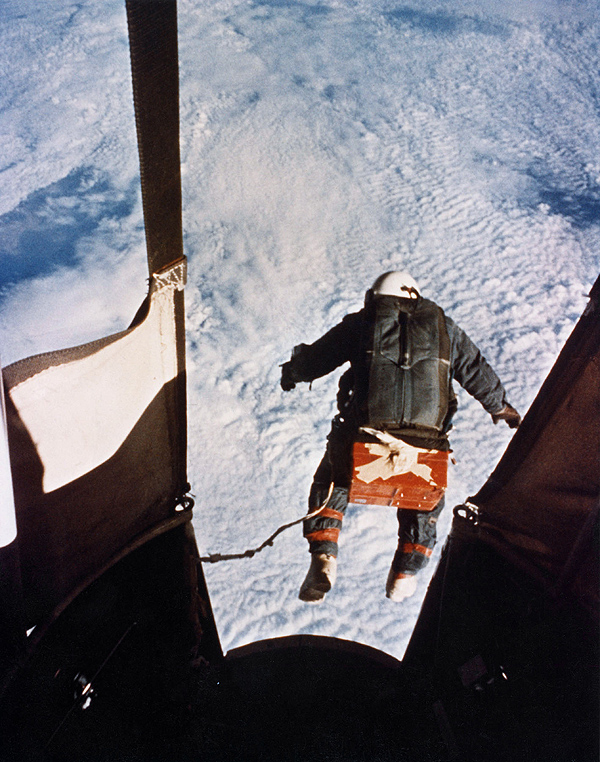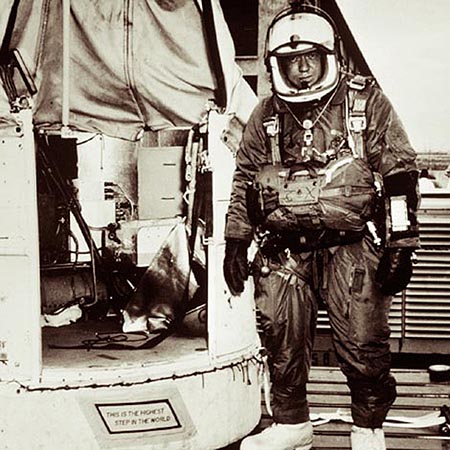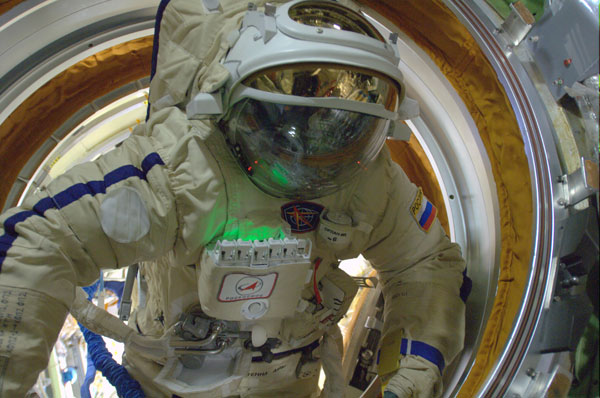The Body at Vacuum
Today, the body at vacuum. The University of Houston presents this series about the machines that make our civilization run, and the people whose ingenuity created them.
In a famous scene in Stanley Kubrick's "2001 A Space Odyssey", astronaut Dave Bowman ejects himself through open space into an unpressurized airlock of the mother ship — this after the HAL 9000 computer refuses to let him in. After a couple of bounces, he manages to close the outer hatch and pressurize the airlock. A desperate survival move, but is it plausible? Hollywood and science fiction vary considerably in depicting the body in open space, from almost negligible effects to messy whole body explosions. Here's some reality.

The Ship Discovery, from Stanley Kubrik's 2001: A Space Odyssey
The vapor pressure of water at body temperature is about one 16th of atmospheric pressure. Below this pressure, which you find above an altitude of about 63,000 ft, body fluids begin to boil away. Moist surfaces experience this immediately, such as the eye, mouth and throat, and airways. Deeper inside, body water in low pressure areas also turns to its gas phase, water vapor. This occurs rapidly in the lung and beneath the skin. Bubbles of water vapor also form in venous blood; these essentially vapor lock the circulation. We call the syndrome associated with the formation of water vapor bubbles in the body at vacuum ebullism. But there is a little more to it.
Because the lungs communicate freely with the outside, a sudden pressure drop causes the air in the lungs to rapidly expand, seeking an outlet. Keeping an open airway ensures that the air rushes outward, better than the alternative of trying to hold it in and causing a traumatic rupture of the lung. But of course respiration is no longer possible. With no circulation and no air to provide oxygen anyway, about 12 seconds of useful consciousness is available.
In human spaceflight, this is a constant threat. In 1971, the Soyuz 11 spacecraft tragically depressurized on entry at over 96 miles; the three unsuited occupants perished.

Cosmonauts Dobrovolski, Patsayev, and Volkov, who in 1971 tragically lost their lives during a high altitude rapid depressurization while their Soyuz spacecraft was about to reenter the atmosphere.
But there are at least a couple of human exposures to whole body vacuum that ended happily. In 1966, a technician testing a space suit in a vacuum chamber experienced a rapid loss of suit pressure due to equipment failure. He recalled the sensation of saliva boiling off his tongue before losing consciousness. The chamber was rapidly repressurized, he regained consciousness quickly, and went home for lunch. Another man was accidentally exposed to vacuum in an industrial chamber; it was at least three minutes before he was repressurized. He required intensive medical care, but eventually regained full function. These instances show that ebullism is not inevitably fatal — and the body holds together just fine.
And so we return to Dave Bowman's predicament. From my rough timing of the movie's events, it was about 8 sec between explosive decompression and activating the handle to repress the airlock, then an additional 4 ' 5 seconds to close the door and begin repressurizing. Could he have managed the feat? The answer is probably. With the presence of mind to exhale and keep an open airway, he may have performed this necessary task without injury. But his was a unique scenario of planned sudden decompression with a pressurized endpoint.
So if you should ever face decompression — well, don't hold your breath.
I'm NASA astronaut Michael Barratt for the University of Houston, where we're interested in the way inventive minds work.
(Theme music)
End Notes:
Aristotle stated in the 4th century BC that 'nature abhors a vacuum'. As has been realized since then however, there is an awful lot of it out there. Away from our planet's surface where the atmosphere is nice and dense, the environment is summarily inhospitable. In a prior episode we discussed the threshold altitude where the surrounding pressure is roughly equal to the vapor pressure of water at body temperature; this is about 63,000 feet, an altitude known as Armstrong's Line. Said another way, the boiling point of water at this altitude is about 98.6 degrees Fahrenheit. As such, for human exposure, you add ebullism to the already present conditions of hypoxia, not enough oxygen, and decompression sickness, similar to what a scuba diver might get if he does not rise slowly enough to let the excess nitrogen out of the body.
The issue of whether Dave Bowman could have done what he did was a favorite discussion topic in my aerospace medical training class at Wright State University many years ago. It forces the consideration of many factors central to human physiology in extreme environments — fundamental among them the need for pressure and oxygen. But all indications are that Stanley Kubrik and his staff did their homework. By the time this movie was made, there had been several studies by the USAF using humans for partial body exposure and animals for whole body exposure to short term vacuum. And of course there was the experience of Jim Leblanc, the suit technician described in the chamber incident in 1966. A remarkable video of this event is shown at this site: http://vodpod.com/watch/3935109-nasas-jim-leblanc-survives-life-threatening-space-vacuum-accidentvideo.
The term ebullism, from the Latin ebullire, to boil up, was first suggested by Captain Julian Ward in a thoughtful treatise in 1956. This was offered as an alternative to simply 'boiling' of body fluids, and is still the preferred term today.
An interesting occurrence of partial ebullism occurred during a high altitude balloon flight, in which Joseph Kittinger experienced a glove pressurization failure while ascending well above the 63,000 feet where ebullism occurs. His hand was described as swelling to about twice normal size and was quite painful. He jumped from a height of over 102,000 feet, free falling for over four minutes and eventually opening a parachute at 18,000 feet. While falling back into the atmosphere, his hand repressurized and returned to normal size and full function.

A remarkable photo taken for the gondola as Joseph Kittinger leaps into the atmosphere from over 102,000 feet.
In the case of explosive decompression, there are of course other hazards and events. Whatever water vapor is in the air instantly condenses due to the rapid temperature drop. Some of us experience this during chamber training, where we undergo a rapid decompression from simulated altitudes of say 8000 feet to over 20,000; this is well below Armstrong's line but it definitely gets your attention when some of the air rushes out of your lungs and fog instantly appears. This was also shown in the 2001 scene. The fog rapidly dissipates as the water turns back into vapor in the surrounding vacuum. For the case of decompressing explosively to complete vacuum, it is possible that even keeping an open airway (mouth open, glottis open) may not present a big enough pipe to allow the air to escape the lungs with an injury causing pressure buildup. In addition, whatever gas may be present in the stomach will instantly expand, and may induce vomiting by forcing stomach contents back up the esophagus as a path of escape. Overall, such events are good to avoid.

Joseph Kittinger in his full pressure suit, preparing for ascent well above the threshold of physiologic vacuum in the US Air Force Man High program.
I was fortunate enough to perform a couple of space walks during my tour on the International Space Station, both in the Russian Orlan space suit. One cannot avoid thinking about the possibility of suit depressurization, and we design and train to avoid this to the extent possible. And while we do not have a ship's computer that controls our vital functions, I did feel some comfort in knowing that we left our airlock hatch wide open.

The Russian Orlan space suit I used for two spacewalks while onboard the International Space Station. This is pressurized to just under 6 pounds per square inch (psi), or about four tenths of an atmosphere. Photo courtesy NASA.
References:
Julian Ward. The True Nature of the Boiling of Body Fluids in Space. Journal of Aviation Medicine, October 1956 27(5) pp. 429-439.
This is one the landmark articles in the aerospace medical literature by one of our pioneers. Captain Ward was tragically lost in an aircraft accident. To honor his memory, the Society of US Air Force Flight Surgeons annually bestows the Julian Ward award for advances in aerospace medicine.
Norfleet, WT. Decompression-Related Disorders: Decompression Sickness, Arterial Gas Embolism, and Ebullism Syndrome Chapter 11. Principles of Clinical Medicine for Space Flight. Michael Barratt and Sam Pool, Eds. Springer-Verlag, 2008.
For those looking for the technical details, Dr. Norfleet wrote a thorough treatise of state-of -the-art understanding of ebullism in our textbook.
Kolesari GL, EP Kindwall, "Survival Following Accidental Decompression to an Altitude Greater Than 74,000 Feet (22,555 m)," Aviation, Space and Environmental Medicine, Dec. 1982, 53(12):1211-1214.
Medical case report of the gentlemen mentioned in the industrial vacuum chamber incident.
Roth EM, "Rapid (Explosive) Decompression Emergencies in Pressure-Suited Subjects," NASA CR-1223, 1968.
This is a NASA technical report that describes the details of the suit technician's mishap, along with a discussion of what was known of ebullism and rapid decompression.
Images:
The Russian Orlan space suit photograph is courtesy of NASA.
The remaining images are from Wikipedia. The "2001: A Space Odyssey" movie image is from Wikipedia and falls under fair use act because of quality and use.
Note added by John Lienhard on Aug. 21, 2108: I have just had occasion to talk with Hank Rotter, a NASA engineer since 1963. He mentioned that he'd worked in vacuum chambers back in the Apollo spacecraft era. So I told him about this episode and the 1966 accident. "I was there when that happened," he replied. It was he who opened the door to the chamber and cut the malfunctioning backpack. He also took pains to say that the real hero of the day was a forgotten technician named R. L. Clay who had the presence of mind to repressurize the chamber immediately when the space suit's backpack malfunctioned. It still took another 87 seconds, but his action saved a life.
The man in the space suit was NASA engineer James LeBlanc who went on to become a Division Chief. Here is a video of the event. In it, you'll see Hank Rotter entering the chamber after the accident. Rotter also remarked that he was perfectly calm when it happened, but that he was seriously shaken in the days that followed. Once he thought about it, the near death of LeBlanc was horrifying.